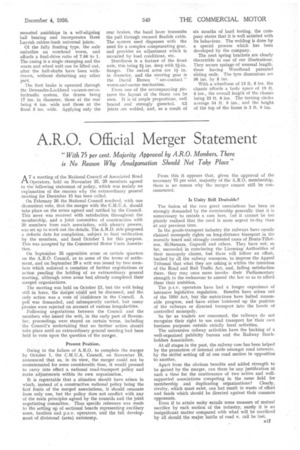A.R.O, Official Merger Statement
Page 51

If you've noticed an error in this article please click here to report it so we can fix it.
"With 75 per cent. Majority Approval by A.R.O. Members, There is No Reason Why Amalgamation Should Not Take Place" AT a meeting of the National Council of Associated Road Operators, held on November 25. 29 members agreed to the following statement of policy, which was mainly an explanation of the reasons why the extraordinary general meeting for December 15 has been called.
On February 26 the National Council resolved, with one dissentient vote, that the merger with the C.M.U.A.. should take place on the terms agreed and ratified by the Council. This news was received with satisfaction throughout the membership, and a joint committee of construction with 20 members from each association, with plenary powers, was set up to work out the details. The A.R.O. side proposed a definite date for completion, subject to final ratification by the members, and fixed October 1 for this purpose. This was accepted by the Commercial Motor Users Association.
On September 25 opposition arose in certain quarters on the A.R.O. Council, as to some of the terms of settlement, and on September 29 a writ was issued by two members which enforced a cessation of further negotiations or action pending the holding of an extraordinary general meeting, although some areas had, already completed their merged organizations.
The meeting was held on October 13, but the writ being still in force, the ineiger could not be discussed, and the only action was a vote of 'confidence in the Council. A poll was demanded, and Subsequently carried, but many proxies were rejected on account of various irregularities.
Following negotiations between the Council and the members who issued the writ, in the early part of November, proceedings were stayed on certain terms, including the Council's undertaking that no further action should take place until an extraordinary general meeting had been held to vote upon the question of the merger.
Present Position.
Owing to the failure of A.R.O. to complete the merger by October 1, the C.M.U.A. Council, on November 19, announced that as, in its view, the merger could not be consummated for some considerable time, it would proceed to carry into effect a national road-transport policy and make adjustments within its own organization.
It is regrettable that a situation should have arisen in which, instead of a constructive national policy being the first fruits of the merged associations, it should emanate from only one, but the policy does not conflict with any of the main principles agreed by the councils and the joint • negotiating committee. Thus specific reference was made to the setting up of sectional boards representing ancillary • users, hanliers and p.s.v. operators, and the full development of divisional (area) autonomy. From this it appears that, given the approval of the necessary 75 per cent, majority of the A.R.O. membership, there is no reason why the merger cannot still be consummated.
Is Unity Still Desirable?
The fusion of the two great associations has been so strongly demanded by the membership generally that it is unnecessary to restate a case here, but it cannot be too plainly realized that the need is more urgent to-day than at any previous time.
In the goods-transport industry the railways have openly claimed monopoly rights on long-distance transport in the recently heard and strongly contested cases of Bouts-Tillotson, McNamara, Gupwell and others. They have not, so far, succeeded in convincing the Licensing Authorities of their monopoly claims, but there will follow an effort, backed by all the railway resources, to impress the Appeal Tribunal that what they are asking is within the intention of the Road and Rail Traffic Act, and, failing satisfaction there, they may once more invoke their Parliamentary strength in the endeavour to amend the law so as to afford them their 'ambition.
The p.s.v. operators have had a longer experience of intensive legislative regulation. Benefits have arisen out of the 1930 Act, but the restrictions have halted reasonable progress, and. have either bolstered up the position of the railways or directed transport into the hands of controlled monopoly.
So far as traders are' concerned, the railways do not recognize their right to use road transport for their own business purposes outside strictly local activities.
The subversive railway activities have the backing of a well-organized publicity bureau and the Railway Stockholders Association.
At all stages in the past, the railway case has been helped by the promotion of internal strife amongst road interests, by the skilful setting off of one road section in opposition to another.
Apart from the obvious benefits and added strength to be gained by the merger, can there be any justification at such a time for the continuance of two active and wellsupported associations competing in the same field for membership and duplicating organizations? Clearly, rivalry, which must exist, can but result in waste of effort and funds which should be directed against their common opponents. . Even if to attain unity entails some measure of mutual sacrifice by each section of the industry, surely it is an insignificant matter compared with what will be sacrificed by all should the major battle of road v. rail be lost.




























































































